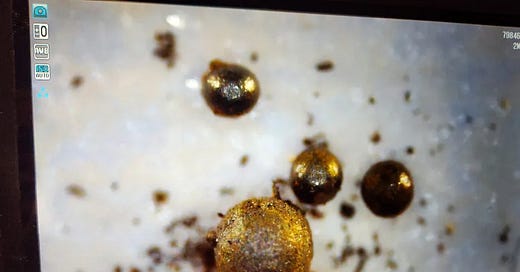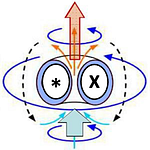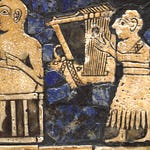Hi, my name is Bob Greenyer and welcome to RemoteView.ICU
When using the term Unidentified Flying Object (UFO), we should know that this can also apply to something created by nature without the action of sentient life. That being said, Avi Loeb does suggest in his videos on the subject, that he considers the ‘interstellar object’ IM1, more than an inter-planetary rock. Moreover, there are direct headlines on the subject that suggest just this, for example:
Harvard Professor Finds Microscopic Debris of Possible Extraterrestrial Technology
You can follow the scientists Medium blog here
I would argue, that these spherules are possibly caused by the phase singularities present in Fractal Toroidal structures, and, the resultant formation and aggregation of coherent ordinary and dark matter, followed by its subsequent collective collapse.
I would really like to see detailed Scanning Electron Microscopy (SEM) and spatial energy dispersive spectroscopy (EDS) maps of these spherules they are recovering from Papua New Guinea.
Researchers in the Martin Fleischmann Memorial Project (MFMP) have produced (crenelated) iron spherules in a range of experiments, having a similar form to those claimed as coming from ball lightning (BL), air-burst phenomena and so called 'micro-meteorites'.
In the case of Alan Goldwater’s ULTR experiment using Al foil in water, up to 3.44% atomic concentration of Mg was found alongside the iron. In my own replication of this ULTR experiment, similar Mg levels were found around the vortex centres where I expect the Fe + O magnetic cores are formed.

Mg is double Carbon, which is produced readily by BL according to the likes of Brown, Solin Matsumoto, so it is not surprising therefore, to find this element as we did outside of carbon on a fractal toroidal Magneto Hydro-Dynamic (MHD) structure in a Dr. Ryushin Ohmasa vibrator plate (OHMA experiment). Of course, any coherent matter raining down from the IM1 “fireball” entered the water, so one might consider they had a similar death to those in ULTR and OHMA experiments, though a different path to initial coherence.
Both ULTR and VEGA crenelated spheres do not contain Manganese, like the claimed IM1 spherules. However, VEGA BL in residual air with hydrogen did reveal structures with high levels of Ti just outside the main Fe + O sphere.
The Fe to O ratio is as high as FeO2 - this is a magnetic substance only 'discovered' in 2017 using Fe2O3 squeezed between diamond anvils at pressures only found deep inside the Earth. Of course our ULTR and NOVA experiments are conducted at around atmospheric pressure, or well below such as in VEGA, so something is forming in these systems that can initiate immense ‘pressures’. I have argued this is the Fractal Toroidal Structure and its embedded toroidal moments and phase singularities.
Our observations have shown, that outside of the Fe + O magnetic core of BL, you get other elements forming
Avi says:
“The metallic pearl-looking spherules are embedded in the volcanic ash and so our goal from now on is to retrieve all the magnetic material available on the sled magnets in the form of black powder and then identify the metallic pearls and separate them with tweezers.”
The presence of ‘volcanic ash’ may be why they do not mention Si and O… however, would not a load of exploded BL, like the one that I identified in Henk Jurrien’s VEGA experiment above, look like “metallic spherules” embedded in ‘volcanic ash’?
Secondly, we know that ball lightning forms in volcanic eruptions, so if it really is volcanic ash, perhaps these spherules are not from IM1 at all!
Regardless, if there are many of these things formed in close proximity in such a dynamic situation as a volcanic eruption or a re-entry 'fireball’ and air-burst, it is likely some will wet together as they move from coherence to liquid elements, unlike the resonance driven NOVA, ULTR and VEGA experiments and so, larger spherules will form, via aggregation, which will include other elements synthesised as inclusions, this is what is observed also in their preliminary work.
I suggest that Avi’s samples may be the typical outcome of non-resonant extremely dynamic BL producing events, as I have previously argued in my prior proposed explanation of the ‘unexplained’ ejecta found as a result of the Fukushima detonation event, which contained a high amount of Carbon alongside volcanic ash minerals and also Fe without Mn but with Ti and Mg.
So to re-iterate, the claimed IM1 fragments of ‘unusual’ and atypical to meteoric material, could be the product of formation of BL coherent objects, due to the high energy and far from equilibrium environment created as the IM1’s original matter entered our atmosphere, traveled through it and into the ocean.
Conclusion
No scientist that studies the products of our openly shared and easy to replicate experiments, should assume that the hardness or elemental composition of the spherules collected from Papua New Guinea are signs of something particularly special, other than the amazing product of the highly dynamic formation and collective effects of many Ball Lightnings, possibly resulting from the interaction of IM1 and our Earths atmosphere and ocean.
Thankyou for listening to RemoteView.ICU
UPDATE 1: 4 Jul 2023 ‘main stream’ interview - Tip off: Ron Kita











Share this post